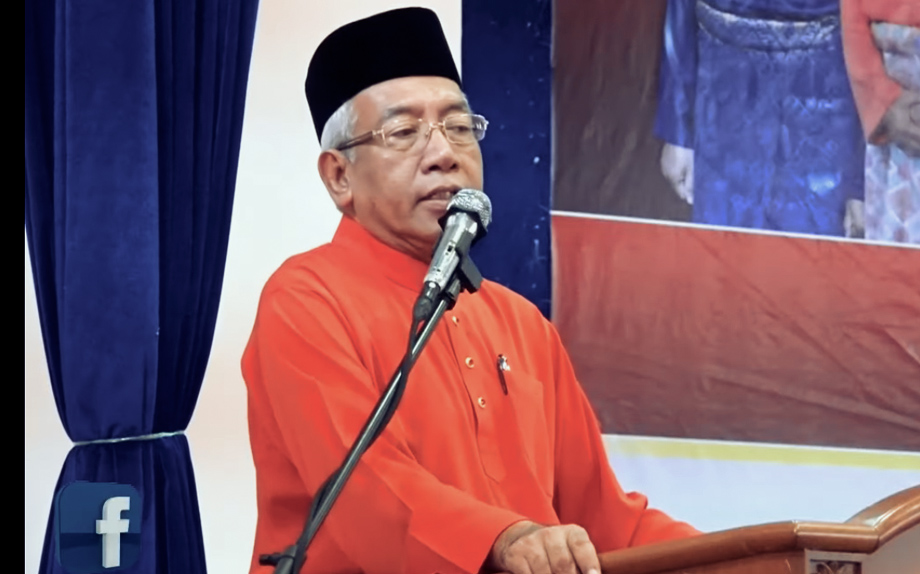ISU berkaitan Pengajaran dan Pembelajaran di Rumah (PdPR) sekali lagi menarik perhatian untuk saya bicarakan selaku Ketua Pasukan Khas Pendidikan Barisan Nasional (BN) yang dipertanggungjawabkan kepada saya.
Ia rentetan bermula pada 13 dan 14 Jun lalu, proses PdPR 3.0 kembali mengambil tempat bagi semua murid dan pelajar sekolah selama 25 hari persekolahan sehingga cuti pertengahan penggal pada 16 Julai bagi negeri kumpulan A dan 17 Julai bagi negeri kumpulan B.
 Sebelum itu pada 25 April 2021, Menteri Kanan Pendidikan, Datuk Dr. Radzi Jidin mengumumkan sesi PdPR 2.0 akan dilaksanakan selama 10 hari persekolahan selepas cuti Hari Raya Aidilfitri.
Sebelum itu pada 25 April 2021, Menteri Kanan Pendidikan, Datuk Dr. Radzi Jidin mengumumkan sesi PdPR 2.0 akan dilaksanakan selama 10 hari persekolahan selepas cuti Hari Raya Aidilfitri.
Dengan angka kes jangkitan COVID-19 yang masih tiada tanda penurunan yang signifikan selain sekatan pergerakan penuh yang berkuat kuasa 1 Jun lalu, saya sememangnya menjangkakan sesi persekolahan secara bersemuka tidak dapat dilaksanakan dan PdPR akan terus bersambung.
Menurut laporan Pertubuhan Pendidikan, Saintifik dan Kebudayaan Pertubuhan Bangsa-Bangsa Bersatu (UNESCO), sejumlah 203 juta pelajar di seluruh dunia terkesan dengan penutupan sekolah berikutan pandemik COVID-19.
Meneliti Manual PdPR Versi Dua yang dikeluarkan oleh Kementerian Pendidikan Malaysia (KPM) pada bulan Februari lalu, iaitu Perenggan 5.1 yang menyebut:-
“Tiada Murid Tercicir Dalam Pembelajaran – Sekolah perlu memastikan semua murid dapat mengikuti PdPR berdasarkan keperluan dan kesediaan mereka. Guru perlu mengenal pasti kaedah PdPR yang sesuai supaya murid dapat menguasai kandungan mata pelajaran yang ditetapkan. Guru hendaklah meneroka cara yang berbeza dan bersesuaian untuk kelangsungan dan peningkatan penglibatan murid dalam PdPR.”
Isu utama yang hendak saya bangkitkan adalah berkaitan kehadiran murid atau keberadaan murid yang mengikuti PdPR.
Kebimbangan saya ini adalah berasaskan kepada hasil kajian Fakulti Pendidikan, Universiti Kebangsaan Malaysia (UKM) yang mendapati kehadiran murid dalam proses PdPR tidak mencapai 80 peratus.
Dapatan kajian itu sungguh menakutkan bagi saya sebagai seorang bekas Pengetua Sekolah yang tentunya risau akan jumlah kehadiran muridnya ke kelas.
Mungkin dapatan kajian itu boleh dipertikaikan kerana proses PdPR mempunyai pelbagai mod iaitu ‘on-line’, ‘off-line’ dan ‘off-site’.
Dalam situasi kita sekarang, sukar untuk menyalahkan mana-mana pihak kerana hakikatnya banyak faktor mempengaruhi apa yang berlaku di rumah.
Secara mudah, para ibu bapalah yang seharusnya mengambil peranan dalam memastikan anak-anak mereka memasuki kelas dalam talian.
Angka kehadiran tidak mencapai 80 peratus itu sebenarnya boleh dianggap sebagai satu isu besar kepada proses PdPR secara keseluruhannya.
 Persoalannya, adakah murid bosan dengan apa yang dihidangkan oleh guru menerusi PdPR?
Persoalannya, adakah murid bosan dengan apa yang dihidangkan oleh guru menerusi PdPR?
Adakah PdPR tidak lagi mendatangkan keghairahan kepada murid untuk terus belajar secara norma baharu?
Atau murid sudah lelah dan penat mengadap skrin komputer atau gajet masing-masing?
Adakah murid kini lebih seronok tidak perlu lagi bangun di awal pagi untuk ke sekolah secara bersemuka dan lebih seronok berjaga hingga ke larut malam serta dapat bangun lewat?
Di sini mungkin peranan guru-guru kaunseling amat diperlukan untuk memperbaiki situasi yang timbul.
Pandangan Mantan Ketua Pengarah Pelajaran Malaysia, Datuk Dr. Amin Senin dalam satu kenyataannya kepada akhbar Utusan Malaysia baru-baru ini wajar diambil kira.
Murid katanya, tidak boleh memberikan fokus 100 peratus jika guru mengajar secara dalam talian dalam tempoh 30 hingga 40 minit mengikut jadual kelas biasa.
Menurut beliau lagi, tempoh pengajaran dalam talian perlu dipendekkan dengan menambah baik dan mempelbagaikan kaedah pengajaran seperti membuat video pendek tidak melebihi 10 minit.
Pendapat itu selari dengan kajian UKM yang diketuai oleh Prof. Madya Dr. Azlin Norhaini Mansor yang mendapati kebanyakan murid tidak memberikan fokus dalam PdPR kerana faktor suasana rumah kediaman yang tidak kondusif.
Sejumlah 70-80 peratus guru melaporkan, cabaran utama PdPR adalah kesukaran mendapatkan perhatian murid.
Kajian juga menunjukkan kaedah pengajaran guru kurang berkesan kerana kurang selari dengan tahap kebolehan dan pembelajaran murid.
Manakala 50-60 peratus guru tidak selesa melaksanakan pengajaran secara dalam talian dan 50-60 peratus guru melaksanakan PdPR antara satu hingga dua jam sahaja.
Kemahiran guru menggunakan peralatan IT pula hanya sekitar 50-60 peratus. Manakala hanya 40-50 peratus sahaja guru yang mahir mempelbagaikan pengajaran secara dalam talian.
Kajian juga menunjukkan komunikasi murid dan guru melalui PdPR sangat terbatas. Ada guru memberikan terlalu banyak latihan kepada murid hingga membebankan ibu bapa kerana terpaksa membantu anak-anak membuat latihan.
Guru pula terikat kerana perlu habiskan silibus selain perlu memberikan laporan sebagai bukti PdPR dilaksanakan.
Semua yang diutarakan itu mungkin sebahagiannya menjadi faktor penyumbang kepada masalah ketidakhadiran murid ke dalam kelas PdPR.
KPM seharusnya tampil mengemukakan segala data berkaitan proses PdPR secara komprehensif bagi membuka mata semua pihak terutama ibu bapa, khususnya berkaitan isu keciciran PdPR ini.
Satu mekanisme perlu dicari untuk mengelakkan murid daripada terus ‘menyepi’ di rumah dan tidak memasuki kelas PdPR tanpa rasa bersalah.
Mungkin tindakan tegas seperti hukuman gantung sekolah perlu dikuatkuasakan jika seseorang murid tidak hadir ke kelas PdPR tiga hari berturut-turut tanpa sebarang sebab munasabah.
Kementerian Pendidikan juga perlu melihat dari aspek teknikal dan teknologi yang mampu untuk memenuhi keperluan murid.
Langkah dan sumber kewangan yang luar biasa amat diperlukan untuk menangani segala permasalahan yang timbul berkaitan proses PdPR.
Pihak KPM juga harus ada ‘roadmap’ yang jelas untuk memulakan kembali sesi persekolahan secara bersemuka agar kebimbangan para ibu bapa terhadap jankitan COVID-19 di sekolah dapat dilenyapkan.
Seterusnya, sebaik sekolah mula dibuka, KPM perlu juga melakukan proses ‘rehalibitasi’ untuk murid-murid yang tidak dapat mengambil bahagian dalam PdPR.
Perlu ada jawapan komprehensif untuk memastikan tiada murid yang tertinggal di belakang akibat tidak dapat mengikuti PdPR secara dalam talian.
Dalam pada itu, kajian oleh Kesatuan Perkhidmatan Perguruan Kebangsaan Semenanjung Malaysia (NUTP), berkaitan pandangan ibu bapa tentang PdPR juga perlu diperhalusi.
Kajian ke atas 16,554 responden itu meminta agar pihak KPM meneliti masalah PdPR yang berlaku kini.
Antara keluhan ibu bapa adalah jadual belajar yang padat serta lambakan kerja sekolah. Ibu bapa yang tidak mempunyai latar pendidikan tinggi juga merasa terbeban untuk membantu anak-anak mereka menyiapkan kerja rumah atau projek yang diberikan.
Ada pihak mencadangkan agar satu modul khas yang mempunyai set arahan kepada ibu bapa supaya boleh memainkan peranan lebih sistematik dan berkesan dalam membantu anak-anak meneruskan proses pembelajaran di rumah.
 Bercakap mengenai PdPR, paling berkait rapat adalah peranti atau gajet. Satu kajian lain pula menunjukkan, kurang 10 peratus murid mempunyai komputer riba yang sesuai untuk digunakan semasa PdPR.
Bercakap mengenai PdPR, paling berkait rapat adalah peranti atau gajet. Satu kajian lain pula menunjukkan, kurang 10 peratus murid mempunyai komputer riba yang sesuai untuk digunakan semasa PdPR.
Manakala Khazanah Research Institute dalam laporan kajiannya bertajuk ‘COVID-19 and Unequal Learning’ mendapati 37 peratus daripada 900,000 murid yang ditinjau oleh KPM, tidak memiliki alat peranti yang sesuai.
Itu juga satu lagi polemik yang masih membelenggu semua pihak dan masih gagal diurus dengan baik dalam isu memperkasa PdPR.
Masalah akses capaian internet khususnya di kawasan luar bandar dan bantuan alat peranti kepada pelajar dari kalangan keluarga B40 juga harus menjadi keutamaan kerajaan sekarang.
Insentif khas kepada warga guru dengan pemberian data internet tambahan untuk proses pengajaran secara digital, penambahbaikan sistem jalur lebar dan kos pembelian alat bantu mengajar secara digital perlu juga diberikan perhatian sewajarnya oleh pihak kerajaan.
Merujuk kepada pembentangan Belanjawan 2021, kerajaan sudah menyediakan peruntukan sebanyak RM50.4 bilion atau 15.6 peratus daripada keseluruhan perbelanjaan kerajaan kepada sektor pendidikan.
Jumlah itu menjadikan pendidikan sebagai sektor kedua tertinggi menerima peruntukan selepas sektor kesihatan.
Bagaimana pula dengan peruntukan untuk program pemberian komputer riba kepada murid?
Setakat 12 Jun 2021, dilaporkan sejumlah 40,290 unit komputer riba telah diserahkan kepada murid di seluruh negara hasil sumbangan daripada sektor korporat dan Syarikat Berkaitan Kerajaan (GLC).
Sewajarnya peruntukan tambahan yang lebih besar untuk projek bantuan komputer riba kepada murid dan penambahbaikan akses capaian internet di kawasan luar bandar menjadi keutamaan kerajaan dalam Belanjawan 2022 yang akan datang.
Apa sekalipun masalah yang timbul, jalan penyelesaiannya tetap ada jika kerajaan mempunyai iltizam yang tinggi untuk menerajui perubahan.
Masalah capaian internet jalur lebar di kawasan luar bandar misalnya, sudah ada solusinya jika mengambil kira perkhidmatan rangkaian jalur lebar terbaharu yang disediakan oleh anak syarikat Tenaga Nasional Berhad (TNB) iaitu Allo Technology Sdn Bhd.
Perkhidmatan Allo menyediakan rangkaian fiber optik milik TNB sedia ada di seluruh Semenanjung yang membekalkan rangkaian internet berkualiti tinggi, terutama ke kawasan pinggir bandar dan luar bandar yang belum tersedia perkhidmatan sedemikian.
Satu kerjasama seharusnya dirangka secara terperinci antara pihak kerajaan dengan penyedia perkhidmatan jalur lebar itu bagi memberi manfaat kepada sektor pendidikan negara dan rakyat di luar bandar khususnya untuk menikmati akses internet itu. – UMNO ONLINE
Datuk Seri Mahdzir Khalid,
Naib Presiden UMNO merangkap
Ketua Pasukan Khas Pendidikan Barisan Nasional
Nota:
Penulis merupakan Mantan Menteri Pendidikan Malaysia (2015-2018) dan juga Ahli Parlimen Padang Terap serta Pengerusi TNB







